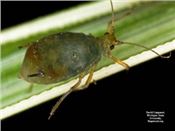Wheat Insect And Weed Control

Bird cherry-oat aphid
DR. ANTHONY OHMES
JACKSON, MO.
Fall insect management targets aphids, in particular bird cherry-oat aphid, primarily to manage barley yellow dwarf virus (BYDV) infection. Begin scouting earliest emerged wheat fields approximately 30 days after emergence. When determining threshold levels consider three factors that make scouting and finding bird cherry-oat aphids difficult: dark olive color; small colonies; feed and hide on lowest leaves and stems near crown. With this in mind, thresholds are generally set low if management of BYDV is primary objective. Threshold range is 6 to 12 aphids per linear foot of row.
Fall weed control targets winter grass weeds: ryegrass, bromes (cheat) and bluegrass. Grass weeds that come up with wheat or emerge in the fall while wheat is trying to establish and tiller will have the largest yield impact. The primary target to scout for is ryegrass. In general, a two pass control program (Fall followed by Spring) will provide good control of problem fields. The primary products for ryegrass control include the ALS-inhibiting herbicides Osprey, PowerFlex or Finesse Grass and Broadleaf and the ACCase-inhibiting herbicide Axial. There has been resistance to these modes of action in Missouri, therefore, consider alternating modes of action. Axiom (PRE) and Zidua (Delayed-PRE) are also available and offer a Group 15 mode of action.
For more information on insecticides and herbicides for wheat refer to Missouri Manual 171: Pest Management Guide http://extension.missouri.e du/explorepdf/ma nuals/m00171.pdf . ∆
DR. ANTHONY OHMES: Agronomy Specialist, University of Missouri